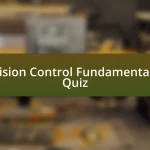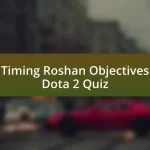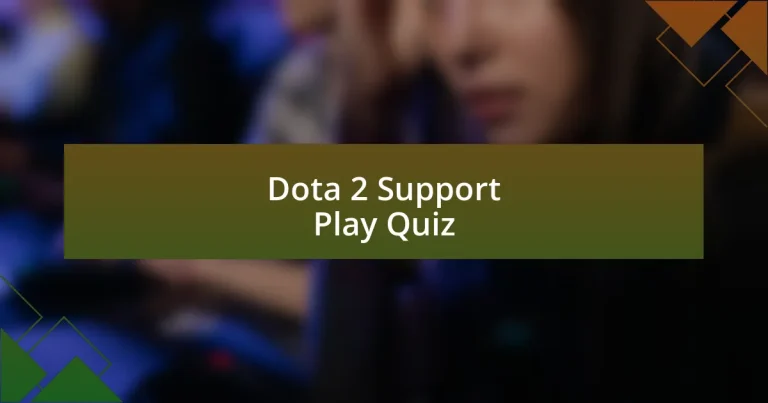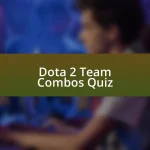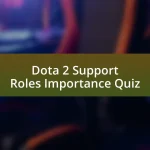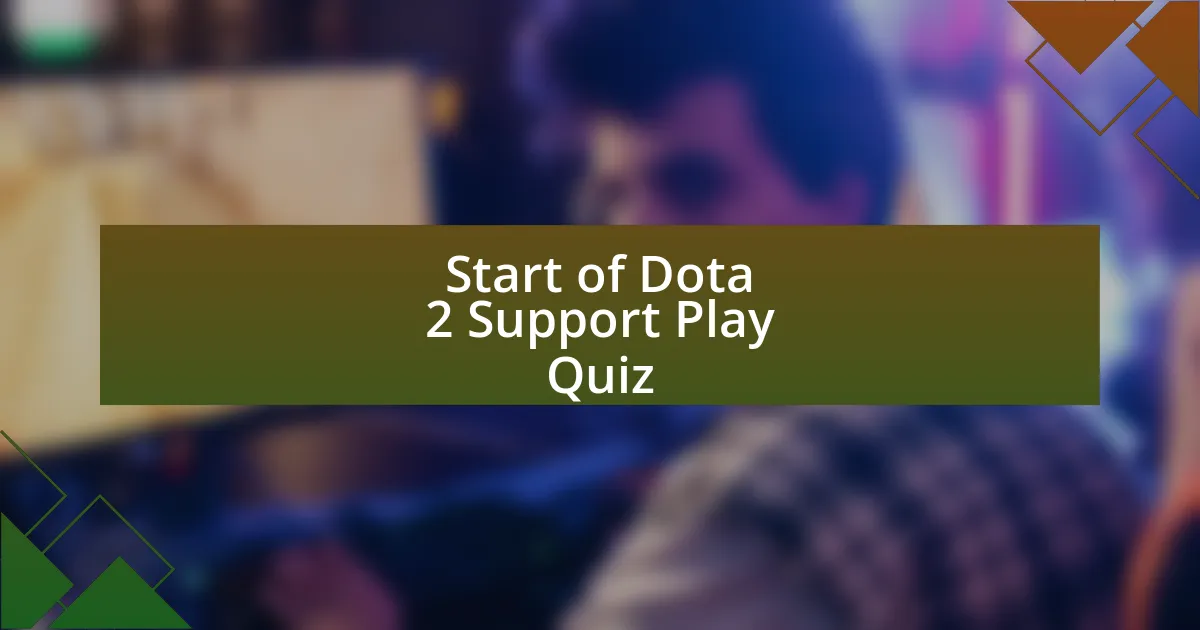
Start of Dota 2 Support Play Quiz
1. What is the primary role of a support hero in Dota 2?
- To initiate team fights and always be on the front lines.
- To deal the most damage to enemies and secure kills for the team.
- To play primarily in the jungle and focus on farming for items.
- To provide healing, crowd control, mana regeneration, disables, and AoE abilities to help the team.
2. Which lane is support heroes usually sent to?
- The mid lane
- The off lane
- The easy lane
- The jungle
3. What is the main task of a support hero in the early game?
- To build damage items and carry the team to victory.
- To engage in team fights and secure kills for the team.
- To farm gold and level up the main hero quickly.
- To control the line by stopping/blocking creeps and making diversions by targeting neutral creeps.
4. How do support heroes typically receive gold?
- By destroying enemy wards, killing couriers, killing Roshan, destroying enemy buildings, and finishing off enemy heroes.
- By collecting runes throughout the match.
- By assisting in team fights for extra rewards.
- By farming creep waves in the jungle.
5. What items are commonly bought by support heroes?
- Consumables like Sentry Wards, Dusts of Appearance, Smokes of Deceit, Healing Salve, and Magic Stick.
- Damage items like Shadow Blade, Silver Edge, Radiance, Maelstrom.
- Weapons like Battle Fury, Daedalus, Divine Rapier, Black King Bar.
- Armor items like Plate Mail, Assault Cuirass, Heart of Tarrasque, Butterfly.
6. What is the importance of level over gold for support heroes?
- Gold is more important than level for support heroes because it boosts their health.
- Gold allows support heroes to buy stronger items than their abilities can offer.
- Level is more important than gold for support heroes because their abilities are crucial for team success.
- Level and gold are equally important for support heroes in the late game.
7. Which support heroes are known for their high mobility?
- Tidehunter
- Dazzle
- Void Spirit
- Lich
8. What is the role of a Position 4 support hero?
- To primarily heal allies and protect the Hard Carry.
- To focus on acquiring vision and detecting enemy wards.
- To be aggressive, roam around the map, gank, grab runes, and help other lanes if necessary.
- To stay in one lane and farm gold from creeps.
9. What is the role of a Position 5 support hero?
- To deal damage and secure kills in the jungle.
- To protect the Hard Carry at all costs and grant vision and detection to the team.
- To focus on farming and gaining gold for items.
- To roam aggressively and gank enemy heroes continuously.
10. Which heroes are good examples of Position 5 support heroes?
- Phantom Assassin
- Lich
- Pudge
- Axe
11. What is stacking in Dota 2?
- The process of buying items to enhance your abilities during the game.
- The strategy of pushing towers while defending against enemy attacks.
- The act of hitting a creep at 53 seconds to make it follow you, causing a new neutral camp to spawn.
- The method of attacking enemy heroes to secure kills and gain gold.
12. What is pulling in Dota 2?
- The ability to teleport to allied heroes when they are in danger.
- The act of hitting neutral creeps to make them follow you every time a creep wave is coming.
- A strategy to avoid enemy ganks by hiding in the forest.
- A technique to gather information by scouting enemy heroes.
13. How can a support hero impact the game in the early phase?
- By roaming, ganking, and killing as much as possible to help winning lanes.
- By staying in the base to support the carry with items.
- By focusing solely on farming to increase gold income.
- By avoiding engagements and letting others take risks.
14. Why is it important for a support hero to be active throughout the match?
- Because it becomes harder to have an impact in mid and late game if they are not active early on.
- Because they can take all the kills and gold for themselves later on.
- Because their presence is only needed during the late game battles.
- Because they should focus on farming instead of teamwork.
15. What are the two types of support heroes in Dota 2?
- Initiator and Escape support heroes.
- Damage and Tank support heroes.
- Position 4 and Position 5 support heroes.
- Ranged and Melee support heroes.
16. Which support heroes are known for their ability to initiate and escape easily?
- Void Spirit
- Treant Protector
- Crystal Maiden
- Winter Wyvern
17. What is the significance of a support hero’s ultimate ability?
- It increases the support hero`s damage output significantly.
- It grants the support hero invisibility for a short time.
- It allows other heroes to fight during their action, providing crucial support in battles.
- It allows the support hero to heal themselves instantly.
18. How do support heroes typically participate in fights?
- By hiding in the jungle and farming gold for items.
- By using abilities to immobilize or slow down enemies, heal allies, or save them.
- By staying far from battles and focusing on defensive plays only.
- By primarily dealing damage to enemies and securing kills.
19. Why are support heroes often considered `sacrificial lambs`?
- Because their role is to deal damage and absorb enemy attacks, making them essential in fights.
- Because they are used to initiate fights and draw attention away from the team’s damage dealers.
- Because they have low health and are easy to kill, but their death does not significantly affect the game’s economy.
- Because they are primarily focused on farming gold and gaining items throughout the game.
20. What is the typical gold distribution for support heroes?
- They receive average gold due to kills and assists.
- They receive the least gold during the game because they do not farm.
- They receive gold mainly through bounty runes and creeps.
- They receive the most gold in the game by farming camps.
21. Which support heroes are known for their slow abilities?
- Dazzle
- Jakiro
- Venomancer
- Warlock
22. What is the importance of vision and detection for support heroes?
- It helps the team by granting vision and detection, which is crucial for positioning and strategy.
- It provides support heroes with more gold than other heroes in the game.
- It allows support heroes to deal more damage efficiently during battles.
- It enables support heroes to take on the role of the main carry for the team.
23. How do support heroes typically manage their gold?
- They spend gold only on luxury items to boost their own stats.
- They give all their gold to the carry hero to help them grow faster.
- They hoard gold for late-game upgrades and hero development.
- They use gold to buy consumables and essential items that enhance their abilities.
24. What are some common support items?
- Artifacts like Necronomicon, Aghanim`s Scepter, and Daedalus.
- Consumables like Sentry Wards, Dusts of Appearance, Smokes of Deceit, Healing Salve, and items like Magic Stick.
- Armor options such as Shield of Valor, Helm of Dominator, and Plate Mail.
- Weapons like Bows, Swords, Axes, and Halberds.
25. Which support heroes are known for their melee abilities?
- Pudge
- Tinker
- Sniper
- Lich
26. What is the difference between melee and ranged support heroes?
- Melee heroes deal high damage and are tanky, while ranged heroes deal less damage but can avoid hits.
- Melee heroes can heal teammates and ranged heroes can`t do any damage.
- Melee heroes play only in the late game, while ranged heroes are only for the early game.
- Melee heroes shoot projectiles, and ranged heroes fight up close to enemies.
27. What is the role of a support hero in controlling the line?
- To gather resources by killing neutral creeps and enemy heroes.
- To stop/block creeps before they reach the collision zone and move allied creeps closer to their own T-1 tower.
- To deal damage to enemy towers and secure kills for the team.
- To roam the map and initiate fights against enemy heroes.
28. How do support heroes typically make diversions?
- By using spells to deal damage to enemy towers.
- By distracting enemy heroes with illusions from items.
- By targeting neutral creeps from the nearest camp at allied creeps.
- By planting wards in dangerous enemy territory.
29. What is the importance of stacking and pulling for support heroes?
- It gives support heroes the ability to take over enemy towers and push lanes efficiently.
- It allows support heroes to deal more damage in fights and control the map effectively.
- It ensures that support heroes can farm gold quickly, helping them buy critical items.
- It helps in managing neutral camps and creeps, which can be crucial for vision and resource management.
30. Which support heroes are known for their ability to grant vision and detection?
- Tiny
- Pudge
- Lich
- Sniper

Congratulations! You’ve Completed the Dota 2 Support Play Quiz!
Thank you for participating in our quiz on Dota 2 Support Play. We hope you found the experience both enjoyable and informative. Quizzes like this one help reinforce your understanding of vital support roles. They also encourage you to think critically about gameplay strategies and item choices. Each question offered insights into the nuances of supporting teammates and advancing in the game.
Throughout the quiz, you may have learned about the essential responsibilities of a support player. This includes warding, pulling creeps, and effectively communicating with your team. Understanding these elements is crucial for any aspiring Dota 2 player. Support roles often dictate the flow of the game, and your knowledge can greatly influence your team’s success.
We invite you to dive deeper into the world of Dota 2 Support Play. Check out our next section on this page for more thorough information and strategies. Expanding your knowledge will sharpen your skills and could enhance your overall gameplay experience. Embrace the journey of learning and keep honing your craft!
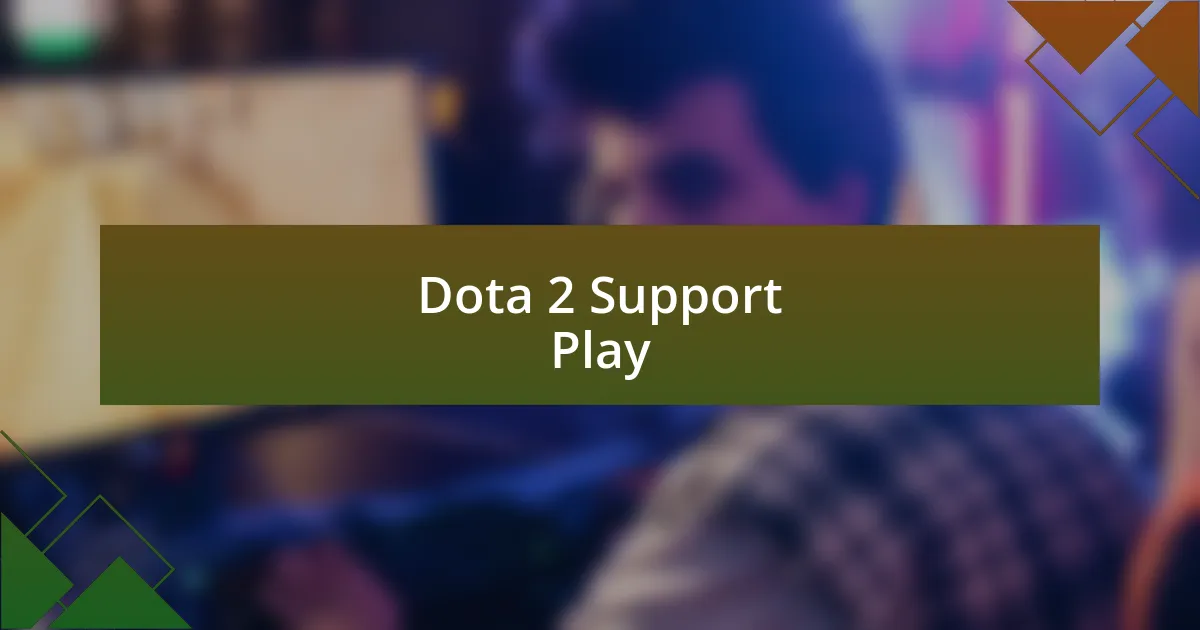
Dota 2 Support Play
Dota 2 Support Role Overview
The support role in Dota 2 primarily assists the team during the game. Supports provide vision with wards, protect core heroes, and control the map. They often sacrifice their own farm for the benefit of the team. They typically have abilities that either disable enemies or heal allies. The support’s impact is crucial for securing objectives and enabling the team’s success in team fights.
Essential Skills for Support Players
Support players must develop several key skills. Map awareness is vital for positioning and understanding enemy movements. Communication is necessary for coordinating plays. Warding and de-warding skills ensure vision control, impacting strategic decisions. Additionally, knowledge of heroes and itemization is essential to adapt to different game situations.
Common Support Heroes in Dota 2
Support heroes vary by their abilities and impact. Some popular choices include Crystal Maiden, known for her crowd control and mana regen; Lion, noted for his single-target disable; and Earthshaker, who can initiate team fights effectively. Each of these heroes offers unique advantages that align with support responsibilities.
Warding Strategies in Support Play
Warding is a crucial aspect of support play. Supports should place observer wards to gain vision over key areas. Sentry wards help deny enemy vision. Understanding optimal warding locations, like high ground and common chokepoints, is essential. Proper ward placement can reveal enemy movements and facilitate successful ganks.
Team Fight Engagement and Positioning for Supports
In team fights, support positioning is critical. Supports should remain close enough to assist teammates but safe from direct damage. Timing disables and heals can turn fights in favor of their team. Additionally, supports often focus on targeting high-value enemy heroes. Successful engagement can significantly alter the outcome of the fight.
What is Dota 2 Support Play?
Dota 2 Support Play involves specific roles within the game that focus on assisting teammates, controlling vision, and enabling strategies. Support players often buy utility items, ward the map for vision, and protect carries during critical moments. They are crucial for establishing map control and facilitating team fights, which helps secure objectives. According to the Dota 2 compendium, supports contribute to about 40% of the game’s overall success through their strategic influence and playmaking abilities.
How do you effectively play Support in Dota 2?
Effective Support play in Dota 2 requires good map awareness, timely rotations, and understanding of hero abilities. Supports should prioritize vision by placing wards and de-warding enemy territory. Communication with teammates is essential to coordinate ganks and escapes. Additionally, buying items that enhance team survivability, such as Glimmer Cape or Force Staff, can turn the tide in fights. Statistics from high-level games show that well-coordinated support players have a 20% higher win rate when they effectively manage vision and item utility.
Where should a Support player focus on the map?
A Support player should focus on areas of the map where their team needs assistance, typically near teammates in the offlane or safe lane during the early game. They should also prioritize key locations for vision, such as the Roshan pit and near objectives like towers and shrines. During mid to late game, Supports often rotate to help secure major objectives or assist in team fights in contested areas. Studies indicate that supports who maintain good positioning near these critical zones increase their team’s chances of victory significantly.
When is the best time to rotate as a Support?
The best time for a Support to rotate is when they see an opportunity for a kill or to secure objectives, such as when enemy heroes are out of position or low on health. Supports should also rotate after securing vision or when their carries are farming safely. Rotating when the enemy is committing to a fight or gank helps swing momentum in favor of their team. Game analytics reveal that successful support rotations lead to a 30% increase in team fight success rate when executed at the right moment.
Who are some of the best Support heroes in Dota 2?
Some of the best Support heroes in Dota 2 include Lion, Chen, and Crystal Maiden, due to their crowd control abilities and utility. Lion offers disable and burst damage, making him effective against key enemies. Chen can heal and convert creeps, providing pressure and objectives. Crystal Maiden provides mana regeneration to allies while having strong area control. According to pick and win rate statistics from competitive matches, these heroes frequently appear in top-tier games due to their effectiveness in supporting the team’s overall strategy.






